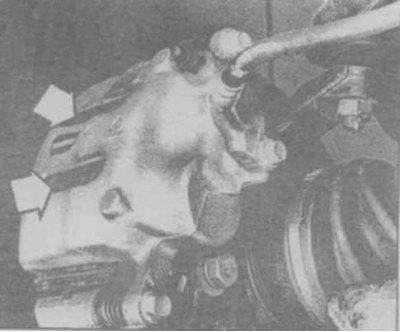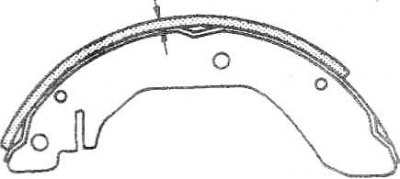2. Raise the vehicle to check.

22.3 Checking the oil level in the rear axle gearbox
Disc brakes
3. Disc brakes are mounted on the front wheels.
4. You can quickly check the residual thickness of the lining material on the brake pads through the window in the front brake caliper (photo). If the wear of at least one lining exceeds 0.8 mm, then replace all four pads as a set.
5. For a more detailed inspection, the brake pads can be removed and cleaned (Ch. 10).
6. Before installing the wheel, check the condition of all hoses and pipelines of the brake circuit, the presence of cracks, corrosion, fluid leaks on them. Replace hose if necessary.
7. Check the condition of the disk, if scuffing, deep wear and traces of strong heating are found, remove the disk and grind it.
Drum brakes
8. Remove the drum. If the drum sticks on the axle hub, drip some penetrating fluid, then try again to remove it.

24.6 Inspection windows in the front brake caliper

23.2 Wheel alignment diagram
1. Along the car; 2. Scheme of rearrangement when equipped with a roller as a spare wheel; 3. Scheme of rearrangement with dual rear wheels; 4. Scheme of rearrangement when equipped with a standard spare wheel
9. If the drum again cannot be removed, then remove the plug on the brake shield and bring the pads together by turning the toothed nut with a screwdriver.
10. As a final means of removing the drums, screw the bolts into the threaded holes and while screwing in, remove the drum (photo).
11. Dust accumulated as a result of pad wear must not be removed by blowing.
12. Check the thickness of the rear pads and their condition. If the thickness of the glued pads is less than 1.5 mm (or distance from pads to rivet heads) less than 1.5 mm, replace the pads. Linings should also be replaced if cracked, glossy, or contaminated with brake fluid or grease (photo).

24.12 Removing the drum by screwing the bolts into the special holes

24.14 Fractional brake lining thickness
13. Check up a condition of springs.
14. Check for traces of brake fluid leakage on the wheel cylinders, for which carefully pry and remove the outer seal of the cylinder (photo). If traces of brake fluid are found under the seal, replace the cylinder.
15. Clean the drum with a rag soaked in alcohol.
16. Check for deep grooves, cracks, gouges and painted areas. If defects cannot be removed with sandpaper, then the drums must be removed and machined.
17. Install the brake drums.
18. Install the wheels and lower the car.
Hand brake
19. Handbrake should be adjusted if 6-10 clicks of the brake lever and neutral gear does not hold the car uphill (Ch. 10).